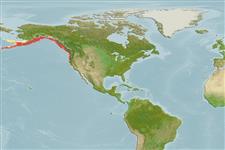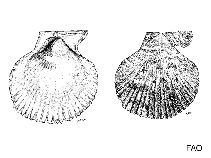Patinopecten caurinus (Gould, 1850)
Giant Pacific sea scallop| Native range | All suitable habitat | Point map | Year 2050 |

|
| This map was computer-generated and has not yet been reviewed. |
| Patinopecten caurinus AquaMaps Data sources: GBIF OBIS |
Google image | No image available for this species;
drawing shows typical species in Pectinidae.
Classification / Names Κοινά ονόματα | Συνώνυμα | CoL | ITIS | WoRMS
Bivalvia | Pectinida | Pectinidae
Environment: milieu / climate zone / εύρος βάθους / distribution range Οικολογία
; εύρος βάθους 2 - 300 m (Αναφ. 114301), usually 60 - 120 m (Αναφ. 114306). Temperate, preferred 7°C (Αναφ. 107945); 64°N - 36°N, 179°W - 120°W
Distribution Χώρες | Περιοχές FAO | Οικοσυστήματα | Παρουσίες | Εισαγωγές
Eastern Pacific: From Pribilof Islands, Alaska to Point Sur, California, USA. Temperate to boreal.
Length at first maturity / Μέγεθος / Weight / Age
Γεννητική Ωρίμανση: Lm ? range ? - ? cm Max length : 28.0 cm SHL αρσενικό/απροσδιόριστο; (Αναφ. 95344); μεγ. αναφερόμενη ηλικία: 15 έτη (Αναφ. 8702)
Life cycle and mating behavior Γεννητική Ωρίμανση | Αναπαραγωγή | Γεννοβολία | Eggs | Γονιμότητα | Larvae
Main reference
Αναφορές | Συντονιστής | Συνεργάτες
Ignell, S. and E. Haynes 2000 Geographic patterns in growth of the giant Pacific sea scallop, Patinopecten caurinus. Fish. Bull. 98:849-853. (Αναφ. 386)
IUCN Red List Status
(Αναφ. 130435: Version 2025-1)
CITES status (Αναφ. 108899)
CMS (Αναφ. 116361)
Threat to humans
Human uses
αλιεία: Εμπορικό(ά)
FAO - αλιεία: landings | FishSource | Η θάλασσα γύρω μας
Εργαλεία
Περισσότερες πληροφορίες
Διαδικτυακές πηγές
BHL | BOLD Systems | CISTI | DiscoverLife | FAO(αλιεία: ; publication : search) | Fishipedia | GenBank (genome, nucleotide) | GloBI | Gomexsi | Google Books | Google Scholar | Google | PubMed | Δέντρο Ζωής | Wikipedia (Go, αναζήτηση) | Zoological Record



